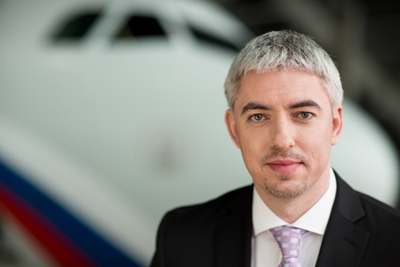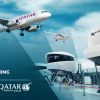 Last week the International Registry of Mobile Assets, a Dublin-based global register of aircraft-related leasing and finance agreements, reached a symbolic milestone marking USD 500 billion worth of registered assets. The impressive number is illustrative of the ongoing growth in demand for aircraft finance across the world. However, considering the ever-changing financing interest and LIBOR rates as well as the complexity of aircraft deal structuring and financial weakness of some airlines, it is only natural to ask which finance model would be the most convenient for new aviation investors?
Last week the International Registry of Mobile Assets, a Dublin-based global register of aircraft-related leasing and finance agreements, reached a symbolic milestone marking USD 500 billion worth of registered assets. The impressive number is illustrative of the ongoing growth in demand for aircraft finance across the world. However, considering the ever-changing financing interest and LIBOR rates as well as the complexity of aircraft deal structuring and financial weakness of some airlines, it is only natural to ask which finance model would be the most convenient for new aviation investors?
The backlog of aircraft manufacturers today is more than three times of the one back in the early 2000, with Airbus alone recently reporting 5907 of aircraft-to-be. However, despite the promising number, a certain portion of the orders (up to 10-15%) is at risk of not being fulfilled due to various factors, including the uncertain financial status of some airlines, the dramatic changes in traffic (military actions, diseases, travel industry turbulences), general over-capacity of a regional market, slowly developing infrastructure, etc.
“Despite all the potential risks most airlines are expected to continue developing and thus will require either new or additional aircraft for their fleets. But, actually, it doesn’t even matter whether a carrier requires a newly-built or a mid-life aircraft. Nowadays less than a quarter of aircraft operators across the world have the sufficient flexibility and confidence to fund the acquisitions of aircraft themselves. The remaining ones turn to banks, leasing companies, capital markets, governmental support, etc.” comments the situation Tadas Goberis, the CEO of AviaAM Leasing.
matter whether a carrier requires a newly-built or a mid-life aircraft. Nowadays less than a quarter of aircraft operators across the world have the sufficient flexibility and confidence to fund the acquisitions of aircraft themselves. The remaining ones turn to banks, leasing companies, capital markets, governmental support, etc.” comments the situation Tadas Goberis, the CEO of AviaAM Leasing.
 matter whether a carrier requires a newly-built or a mid-life aircraft. Nowadays less than a quarter of aircraft operators across the world have the sufficient flexibility and confidence to fund the acquisitions of aircraft themselves. The remaining ones turn to banks, leasing companies, capital markets, governmental support, etc.” comments the situation Tadas Goberis, the CEO of AviaAM Leasing.
matter whether a carrier requires a newly-built or a mid-life aircraft. Nowadays less than a quarter of aircraft operators across the world have the sufficient flexibility and confidence to fund the acquisitions of aircraft themselves. The remaining ones turn to banks, leasing companies, capital markets, governmental support, etc.” comments the situation Tadas Goberis, the CEO of AviaAM Leasing.The acquisition of newly-manufactured aircraft attracts large interest (and range) of financial players. There reasons for that are measurable risks, predictable returns as well as an increasing market demand and higher residual values of such aircraft. At the same time, one won’t find export credit agencies (ECA) and, most likely, capital market solutions in the mid-life aircraft segment.
The same goes for 15+ years’ old aircraft, which are usually acquired in cash, leased from a leasing company or financed with a bank loan. However, in rare cases, when banks are reluctant to finance such acquisitions, there is a chance to attract capital market players. For example, recently Castlelake Aircraft Securitization Trust has formed an almost 80 aircraft portfolio backed by capital market financing. The average age of the fleet has been 17.5 years and total value has exceeded USD 736.5 million. The aircraft have been leased to over 25 lessees while the investors are enjoying 5.5% and 7.5% yields for A and B-class bonds.
SQUEEZING TRADITIONAL FINANCING
Western banks had long been a “traditional” source of financing for many aircraft operators. However, during the crisis, many of them left the market due to the lack of liquidity to support such capital-intense assets as aircraft. Today some of them (mainly German and French ones) are returning, though the market has changed.
“Yes, airlines seem to be already back on track with over USD 10 billion in net profits, meaning that the industry is once again starting to look promising for the banks, and not only the European ones. In the last couple of years the share of Asian (mainly Chinese) banks in the aircraft finance market has almost doubled,” shares Tomas Sidlauskas, the Senior Project Manager at AviaAM Leasing.
A 7-8 years’ old (mid-life) Boeing 737 NG might be found on the market for approx. USD 25 million. An operator may usually receive an up to 80% loan whereas the rest comes as its own equity. On average, an operator may receive a USD 20 million financial loan with an interest rate in a 3.5-4.5% corridor, plus the 3 month LIBOR rate (0.23% as of early October 2014) and a USD 5 million balloon payment at the end of loan period. As a result, a 60-month bank loan will cost the carrier approx. USD 2.7 million.
 “Certainly, the interest rate varies from an airline to an airline. It may be as low as 2% and as high as 4.5-5%, depending on the carrier’s financial situation, its country of origin, economical and political situation in the region and many other factors. But in any case the loan money will be getting more expensive as the banking industry further implements Basel III,” comments Gediminas Ziemelis, the Chairman of the Board at AviaAM Leasing.
“Certainly, the interest rate varies from an airline to an airline. It may be as low as 2% and as high as 4.5-5%, depending on the carrier’s financial situation, its country of origin, economical and political situation in the region and many other factors. But in any case the loan money will be getting more expensive as the banking industry further implements Basel III,” comments Gediminas Ziemelis, the Chairman of the Board at AviaAM Leasing. Basel III was designed in 2010-2011 in order to prevent the global banking system from yet another major liquidity crisis. Though the implementation of new standards is postponed until 31st March 2019, Basel III countries will require from their banks to significantly improve the quality of their assets in order to be able to sell them under emergency conditions and prevent themselves from immediate insolvency.
Amongst other, Basel III treats aircraft as an illiquid asset meaning that a bank is required to reserve more capital to support the aircraft loan than, for example, in case of a mortgage. This eventually will not only make aircraft loans more expansive than they are today, but will also require more time and other resources in order to convince the banks of one’s creditworthiness. Thus, while the banking system is facing more scrutinized future, aircraft financing opens new opportunities for those not regulated by Basel III.
EETC AND OTHER ALTERNATIVES
Capital market players are among those who have been actively increasing their presence in the aircraft finance over the past several years. According to Boeing, airlines across the world have attracted almost USD 23 billion through various capital market tools in 2013. In 2014 United Airlines alone have issued a USD 949 million worth of enhanced equipment trust certificate (EETC).
According to Tomas Sidlauskas, EETCs have one major advantage. “When providing a loan, the bank primarily focuses on an airline’s credit rating which influences the overall cost of borrowing. In the meantime, EETCs are usually issued based on the value of the asset itself. This allows to lower the interest rates and attract more potential investors. In case the operator of an aircraft goes defunct or becomes insolvent, the certificate holders take over the ownership of the asset. But do they know what to do with it next? Liquidation of an asset in the case of the carrier’s bankruptcy and distribution of its remaining is a time-consuming and costly process.”
COMFORTING STABILITY OF THE LEASING MARKET
Regardless of whether an investor aims at short or long-term/capital small or intense investment, leasing companies are present in both new and mid-life aircraft markets (unlike the capital market and most banks). Moreover, many leasing companies have much more stable financial flows and capital reserves which, in turn, provide them with an ability to acquire cheaper aircraft financing than the one available for the majority of airlines.
An overall 60-month finance lease of a mid-life Boeing 737 NG (market value ~ USD 24-25 million) might be more expensive than a bank loan by several basis points, but it will give the carrier larger financial flexibility during the lease period as monthly payments will be approx. 20% lower than the ones under a bank loan (depending on the size of the balloon payment). In addition, the payments will be fixed over the entire period thus securing airlines from interest/LIBOR rate fluctuation risks.
At the same time, those carriers which do not feel the need for actually owning an aircraft (i.e. just operating one) prefer operating lease as it doesn’t burden their books and cash flows unlike loans or financial leasing do. This leasing model allows carriers to remain flexible and “in the air” should the market conditions change.
But there is a certain challenge for the leasing company to satisfy the demand. A major issue for a leasing company is finding a large equity investor who is willing to deploy rather big capital into aircraft assets. From an investor’s point of view, usually one doesn’t own enough know-how and experience to manage such assets effectively.
“Should an investor and a leasing company join their efforts, the latter will gain access to required funds, while the former will secure its investment from unplanned depreciation and inefficient utilization,” shares Gediminas Ziemelis, the Chairman of the Board at AviaAM Leasing. “An aircraft leasing company has the competence and experience to ensure appropriate technical management of the asset (i.e. control its exploitation and maintenance) and to promptly relocate the asset should the primary carrier for some reason cannot operator it any longer. Leasing as a more stable means of aircraft financing is being acknowledged by traditional players too, as we see more and more banks engaging in aircraft leasing rather than just loaning the money. The trend is being also stimulated by the fact that leasing is not covered by Basel III. But, regardless of whether one is a traditional financier, private or an institutional investor, it’s important to understand that 15-20% ROIs comes only as an award for thorough and deep understanding of all the ins and outs of such a complicated industry as aviation.”





